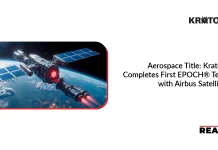Terran Orbital Corporation, a global leader in satellite solutions, primarily serving the United States and Allied aerospace and defense industries, is humbled to share in the Mission of the Year Award presented to the CAPSTONE mission team at the Small Satellite Conference. Competition entrants were chosen for their ability to demonstrate a significant improvement in the capability of satellites, spacecraft structural design, scientific instrument development, and communications capabilities. The contest was informed by the public and administered by the American Institute of Aeronautics and Astronautics Small Spacecraft Technical Committee. CAPSTONE topped ten other highly technical satellites to win the award.
“Terran Orbital is humbled to be included in the Mission of the Year award,” said Terran Orbital Co-Founder, Chairman, and Chief Executive Officer Marc Bell.
Terran Orbital developed and co-operates the Cislunar Autonomous Positioning System Technology Operations and Navigation Experiment, otherwise known as CAPSTONE, in cooperation with NASA and Advanced Space. The groundbreaking lunar orbiter is testing and verifying the calculated orbital stability planned for the Lunar Gateway space station as part of NASA’s Artemis program. CAPSTONE is set to complete its mission in record time at an unprecedented low cost.
Weighing in at 55 pounds, CAPSTONE is the first spacecraft to test a unique, elliptical lunar orbit. The orbit, formally known as a near rectilinear halo orbit (NRHO), is significantly elongated – serving as a precise balance point in the gravities between the Earth and the Moon. NRHO requires less propulsion capability for spacecraft flying to and from the Moon’s surface than circular orbits. CAPSTONE will reduce risk and increase capabilities for future spacecraft by verifying the halo-shaped orbit’s dynamics and validating the innovative navigation technologies necessary to fly the orbit.
“Terran Orbital is humbled to be included in the Mission of the Year award,” said Terran Orbital Co-Founder, Chairman, and Chief Executive Officer Marc Bell. “Our engineers spent countless hours developing and perfecting the CAPSTONE spacecraft and are now carefully guiding it to the Moon. We are incredibly grateful to NASA – and all our partners – for the opportunity to participate in and contribute to the historic Artemis program. Charting a new path to the Moon is only the beginning.”
The spacecraft will come within 1,000 miles of one lunar pole on its near pass and 43,500 miles from the other pole at each seven-day peak. CAPSTONE is set to complete apogee at the end of August and will arrive at the Moon on November 13th.




